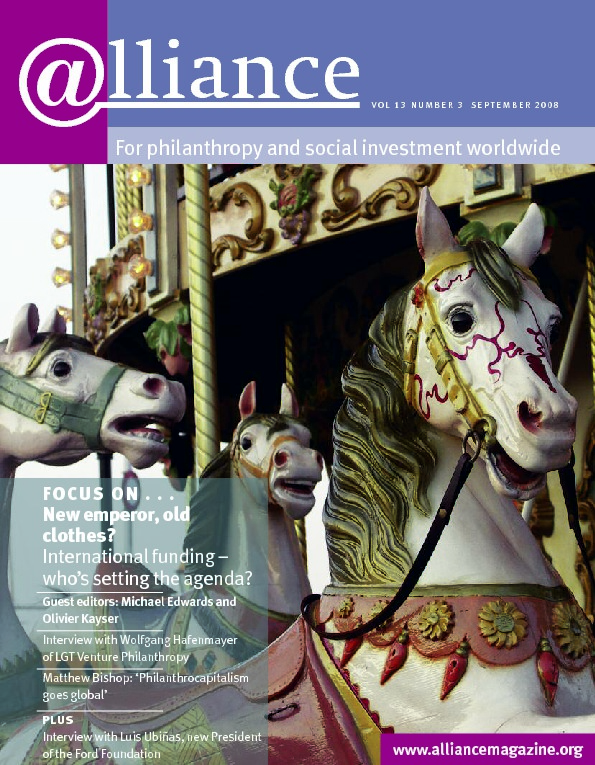 Like any other sector of society, a healthy philanthropic sector needs the scrutiny of external watchdog organizations as well as appropriate governmental regulation and oversight. But ensuring that the watchdog does not turn into a lapdog is a challenge that bedevils even countries with well-developed philanthropic sectors and confounds those where the sector is only beginning to build an infrastructure.
Like any other sector of society, a healthy philanthropic sector needs the scrutiny of external watchdog organizations as well as appropriate governmental regulation and oversight. But ensuring that the watchdog does not turn into a lapdog is a challenge that bedevils even countries with well-developed philanthropic sectors and confounds those where the sector is only beginning to build an infrastructure.
In the US, the non-profit trade associations representing foundation members sometimes establish ethical behavioural or governance standards but they just about never take a hard, publicly critical line on the accountability shortcomings of their constituents. In the US, the Council on Foundations or Independent Sector might at times excoriate a philanthropic scoundrel – the belated CoF criticism of the out of control spending and compensation practices of the Getty Trust in Los Angeles is a case in point – but in general they tend to remain silent about the excesses of their dues-paying members, not to mention those of the thousands of other ‘free-rider’ organizations.
In the US, the non-profit watchdog of foundations for the past three decades has been the National Committee for Responsive Philanthropy (NCRP). Facing foundations sitting on well over half a trillion dollars in assets, NCRP may be more ‘watchpuppy’ than watchdog (its annual revenues have rarely exceeded $1 million, compared to the more than $11 million taken in by Independent Sector and $17 million by the Council on Foundations in 2005), but that does not mean that it cannot help to promote a more accountable and responsive philanthropic sector. Over the years NCRP and allied organizations have helped place on the public agenda issues such as the inadequate level of foundation grants payout, the sometimes excessive compensation of foundation trustees, and inadequate grantmaking for disadvantaged and disenfranchised populations.
NCRP’s experience suggests a few lessons to consider when constructing watchdog organizations for the foundation sector.
Avoid being captured
The core problem is how to avoid being captured by the sector that is being watched. Most watchdogs in the US eventually turn into lapdogs, identifying more with the institutions they scrutinize than with the interests of the public they are supposed to represent. The board members of a watchdog organization have to hold the organization’s feet to the fire, attentive to the almost inevitable loss of ‘edge’. Sometimes the monitored sector responds by setting up its own ersatz watchdogs, akin to ‘company unions’, meant to highlight the progress the sector is making on its own towards increased accountability. Worse, the sector sometimes attempts to infiltrate and take over independent watchdogs in order to change their position on key issues of accountability.
Encourage others to speak out
There are some 90,000 grantmaking foundations in the US of varying types and it is impossible for any one organization to keep up with all of them. To be effective, a philanthropic watchdog has to spark citizens and other non-profits themselves to speak up about philanthropy, point out what they see as needing correction, and monitor the scores of diverse foundations that the national watchdogs cannot possibly track on their own.
Non-profit grant recipients have to see their legitimate right to challenge philanthropy in the same way as they question the policies and priorities of government and corporations. This doesn’t come naturally to non-profits, more accustomed to the role of supplicant to foundations. With foundations, unlike governmental agencies, non-profits have no means of redress such as administrative complaint or litigation, nor any formal mechanism for challenging grantmakers’ funding decisions as violations of their programme guidelines or mission statements. They cannot vote out foundation trustees.
But foundations have been entrusted with the stewardship of tax-exempt moneys for the public benefit, and citizens and non-profits have a right – and perhaps a responsibility – to speak out about organized philanthropy. If foundations want to insulate themselves from scrutiny, they can declare the funds entirely private and forgo the governmental tax exemption while continuing their purported good works.
Don’t expect to be liked
The role of philanthropic watchdogs is not simply to uncover foundations falling short of the public trust but also to underscore what they can do to better live up to their public responsibilities. In order to be seen as something other than an inveterate scourge, watchdogs sometimes fall prey to wanting to be liked by the entities they monitor. They are admonished to be ‘constructive critics’ (presumably in contrast t0 ‘destructive critics’), sometimes leading them to soft-pedal criticisms or to focus on promoting favoured foundation grantmaking priorities. There is nothing inherently wrong in promoting grantmaking for underserved constituencies, for example, but only so long, as one longtime foundation watchdog has noted, as the strategy is to ‘kick ass’ rather than ‘kiss ass’. In the US, foundations have become so public relations-focused that it is hard to discern the really good examples of foundation grantmaking from the spin.
Back up positions with research
The credibility and potential effectiveness of a philanthropic watchdog does not come from broad-brush complaining. Its criticisms have to be backed up by good-quality research and analysis to identify and explain issues to the public (and the mainstream press) and to establish the bona fides of the watchdog as an organization warranting serious attention. The institutional defenders of the status quo will sometimes mobilize academics, more frequently philanthropic consultants, with loyalties bought and paid for by the prospects of future contracts and grants, to mount furious and better-funded counterattacks. But the defensive research of the sectors in question should not deter watchdogs from generating and interpreting their own empirical data.
Walking the tightrope
Without much of a mobilized constituency of their own – because foundations contribute only one-tenth of non-profit revenues, many non-profits do not see foundation accountability as a high priority – philanthropic watchdogs are vulnerable to punitive grant decisions should their criticisms cut too close to the bone for their foundation funders.
The non-governmental philanthropic watchdog organization thus balances on a precarious tightrope, dependent for its survival largely on the grant support of the sector it is charged with monitoring. The alternative is a philanthropic sector in which external scrutiny, already in scant supply in the underfunded initiatives of the federal Internal Revenue Service and state attorneys general, plays little or no role in compelling foundations to do more and do better. Perhaps, instead of watchdogs, they should be thought of as canaries in the coal mines, providing an early warning system for government regulators and for foundations themselves about behaviour and policies that need corrective action.
Rick Cohen is a reporter for Nonprofit Quarterly and served as Executive Director of the National Committee for Responsive Philanthropy 1999-2006. Email rick@npqmag.org
Comment David Emerson
Rick Cohen presents clearly the risks for any philanthropic watchdog. But he also set me thinking as to whether a healthy philanthropic sector really does need both the scrutiny of external watchdogs and governmental regulation. Where there is taxable benefit, this clearly needs government or alternative regulatory oversight (as is provided by the Charity Commission or Office of the Scottish Charity Regulator in the UK). The sector must also ensure it complies with other relevant legislation – whether that’s on data protection, working with children, or much else.
But does it need more? A unique contribution of foundations is to respond to the needs of society as they best see fit. At the time, that response may seem inappropriate, maverick, politically unpopular, or all of these simultaneously. But just sometimes this will prove to be the perceptive and necessary response that no others can provide. Arguably, therefore, foundations should remain free of watchdogs in order to make this contribution. For me, foundations’ greatest asset is to be an active part of a diverse and pluralist society.
So should philanthropy membership associations play any role in ‘policing’ the foundation sector? We should certainly aspire to support our members in constantly improving their practice in grantmaking and governance. This could indeed be through codes of practice, but always using peer-to-peer experience as a tempting carrot as there are precious few sticks we can use, and they have such limited impact.
But I do endorse two other linked points from Rick Cohen’s analysis – the first being that non-profits have no formal mechanism for challenging grantmakers. Could we establish effective forums through which foundations hear genuine, clear feedback on how they work? These might not be watchdogs in name but they could move us towards Cohen’s final comment on the value of having more canaries for our philanthropic mines. Their songs would provide those foundations keen to maintain continuous improvement with an early warning system they are anxious to hear.
David Emerson is Chief Executive of the Association of Charitable Foundations in the UK. The paragraphs above are informed by his work, but he writes in a personal capacity. Email David@acf.org.uk






Comments (0)